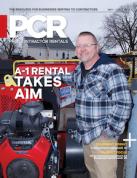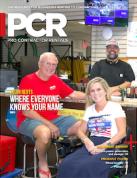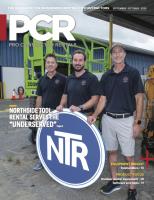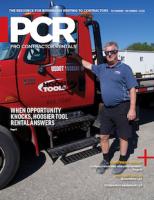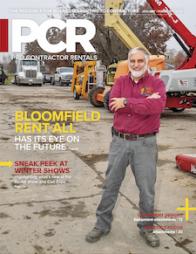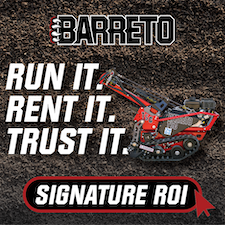Industry outlook: Skid steer loaders/compact track loaders
These load-and-carry machines are growing in number and applications. Experts from Bobcat, ASV, Caterpillar, Cratos, Ditch Witch, Fecon, Manitou and Morbark share their insights.
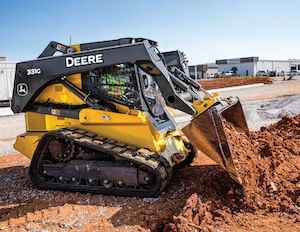 |
| Compact track loaders have gainined in porpularity over skid steer loaders, bue each has a viable place in the rental market. |
Although compact track loaders have gained popularity with users and rental centers, skid steer models still provide an economical and reliable alternative where there is solid underfoot conditions. In both cases, increasing interest in powered attachments and new-generation battery-powered units are driving selection decisions for new models. Here’s where industry-leading experts think this market segment is heading.
New models offer easy operation, maintenance
Rental centers and their customers continue to favor compact track loaders over skid steer loader models, as has been the ongoing trend.
 |
|
SARAH PECKSKAMP |
Compact track loaders are often the best fit for a wide range of rental customer needs, offering superior digging and pushing power, increased flotation and minimal ground disturbance. Each year, renters grow more familiar with the value of compact equipment, and they rely on rented compact loaders to lift more, run harder, complete bigger jobs and do more in less time. Bobcat’s new R-Series loaders are completely redesigned from the ground up to do just that. They give rental businesses the quality, reliability and durability they need for maximum uptime, with the serviceability needed to keep it earning well with minimum effort. The ease of use of these models ensures renters of all skill levels can quickly get to work with an R-Series machine.
Attachments add value
Attachments are hot right now for skid steers and compact track loaders. Renters and rental fleet owners are looking for ways to continue to optimize the rental experience.
 |
|
DEREK BETCHER |
When you can add easy versatility and productivity to a proven machine like a John Deere skid steer or compact track loader, people are interested.
For example, the John Deere Quik-Tatch coupler has been standard on several series of John Deere skid steers and compact track loaders. It enables attachments to be quickly shared among skid steers, compact track loaders and compact wheel loaders, which increases the value for the customer.
General-purpose buckets and pallet forks are the most utilized attachments among renters because of their versatility, followed by grapple buckets. These attachments can handle a majority of the materials being moved around a job site. More specialized attachments such as hammers, augers and pickup brooms have proven to be valuable to renters because they excel at specialized tasks.
Customers are showing great interest in John Deere RB72, RB84 and RB96 rollout buckets. When a machine’s lift height is limited, these buckets provide an additional 34 inches of dump reach. They optimize nicely on the new G-Series compact track loaders. Rather than requiring the machine hinge pin to be raised higher than the hopper for dumping, roll-out buckets pivot near their cutting edge for additional dump height. This helps renters reach new heights with a compact machine.
In 2019, the rental industry showed growth in machines with a rated operating capacity greater than 3,000 pounds, which are the industry’s largest. This includes the John Deere 330G and 332G skid steers and 331G and 333G compact track loaders. This could signal there is a rental customer group looking for top productivity in compact equipment.
Skid steers and compact track loaders are versatile machines that can tackle a range of jobs and projects. Looking at nationwide rental industry data, the market for tracked machines is more than double the market for wheeled machines and through 2019, it continued to grow. Early in calendar 2020, wheeled machine sales have regained some momentum compared to their tracked siblings but it’s probably too early to tell if they will offset in 2020 tracked machines’ overall strong popularity.
Operators getting ready to rent should evaluate their needs, the job site conditions and the specific activities planned to help decide between renting a compact track loader or skid steer. Understanding the differences between skid steers and compact track loaders will ultimately improve the productivity on the job site. For work on job sites that include soft ground conditions or steep terrain, compact track loaders are better suited.
If an operator needs increased mobility and is working on hardscapes, the style of tires on a skid steer loader will make a difference on the job. To limit the risk of damage, rental companies often outfit skid steers with solid tires. This would be a smart recommendation for renters doing any kind of demolition work thanks to their puncture resistance. While tracks don’t go flat, there is some risk of damage if used in conditions like broken concrete, rebar or sharp rock. Conversely, tires have higher ground pressure than tracks, so skid steer loaders are more likely to sink in softer ground conditions.
Smaller track loaders gaining traction
Just like buyers, rental centers are starting to trend toward compact track loaders for the extended capabilities over their wheeled counterparts. Tracked machines handle a wide variety of terrain and ground conditions better than skid steers, be it mud, snow or ice.
 |
|
Buck Storlie |
Also, rental houses are seeing more of an interest from customers in track loaders on the smallest end of the spectrum, especially as more manufacturers introduce machines in that segment. ASV introduced the smallest sit-in compact track loader two decades ago and continues to hold the spot for the smallest models on the market, the Posi-Track RT-25, RT-40 and new RT-50. These machines offer ground pressures as low as 2.8 psi, have operating weights as little as 3,755 pounds and are as compact as 48 inches wide.
The benefit is the ability to do more work in more places, such as between houses in highly populated areas without the need to remove sections of fence and through alleys and on sidewalks. This can open up the door to business from weekend warriors and contractors working in tight spaces. The machines are also extremely user-friendly,
especially for a first-time user such as a homeowner who may be intimidated by the size of a large or even mid-size machine. Rental centers and their customers appreciate the machines’ ease of serviceability and the ability to transport the loaders with a 1/2-ton pick-up. It’s convenient both for customers who don’t have a vehicle powerful enough to pull a larger machine, as well as operations that do have the capacity to haul larger units but prefer the ease of use and cost savings of smaller equipment.
Rental centers are seeing opportunities from customers interested in eventually purchasing a compact track loader for their business or home use, but first want to rent one and give it a try. Rental stores can also generate more revenue from a compact track loader because it can be billed at a higher than a skid steer.
In addition, centers have the opportunity to increase uptime and return equipment to rentable condition as fast as possible by ensuring they always have necessary replacement parts, fluids and filters in stock. It could mean losing business to a competitor down the road if the machine a customer needs as soon as possible is unavailable due to waiting on service.
There are opportunities for rental providers to give their customers a wide range of compact track loader options from a single manufacturer. For example, ASV offers the smallest sit-in compact track loaders on the market, including the 48-inch-wide RT-40 that gives customers the power of a mid-sized machine in tight spaces. ASV also manufactures the industry’s largest, most powerful loader, the RT-120 Forestry model. Machines as large as the RT-120F give operators the ability to complete more demanding jobs such as mulching or asphalt planing and milling. That means rental centers can offer the large track loader as a versatile, much easier to use and transport alternative to a large dedicated machine.
Contractors continue to see the benefits of compact track loaders’ low ground pressure that causes less turf damage and potentially more profit. A tracked machine can go more places, so customers sometimes rent a track loader even if a skid steer could do the job.
The benefits of low ground pressures and high performance are even more accentuated in ASV machines. The patented Posi-Track undercarriage spreads weight more evenly than other compact track loader designs, allowing for more flotation and better handling on difficult ground conditions as well as limiting the risk of damage on sensitive turf.
Skid steers have their place
The mid-sized rubber tire and rubber track loaders are popular with rental customers due to the high performance that is delivered in a relatively compact chassis size. This size is also easy to transport and can nimbly maneuver on tight job sites. The performance they can deliver allows them to be paired with many different attachments, from buckets and forks to the more complex hydro-mechanical attachments for added versatility. This versatility allows for excellent asset utilization and potentially more revenue for rentals that include multiple attachments.
|
KEVIN COLEMAN |
Rental centers are also looking for equipment that’s easy for them to maintain, easy for the customer to maintain and ways the equipment can be used without damage. Machines that provide in-cab monitoring and messaging to communicate when routine maintenance is required is a huge benefit for the customer and the rental center.
In addition, daily checks/fill items, such as engine oil, should be easy to accomplish without having to reach into areas where components may be hot. Routine maintenance items, like cleaning/replacing the engine air filter, should be quick and simple without requiring removal of bolts or panels. Other routine maintenance items, like the fuel or hydraulic filter, should be straightforward to find and access without requiring other components, like cabs or cooling cores, to be unbolted and moved. All of these features lead to better maintenance when on rent and quicker turnaround when the equipment comes off rent.
Items such as integrated rearview cameras also benefit the rental customer with enhanced job site visibility, especially behind the machine. A rearview camera also helps protect the unit from backing into objects, causing damage that can affect future rentals.
Skid steer loaders still have a place in rental to service many applications, whether it be paving, agriculture, landscape supply or nurseries. A skid steer fits well in applications where the ground conditions are firmer and/or where higher travel speeds are required. Also, skid steers typically weigh less than a rubber track machine which allows for more flexibility for transport and potentially allow more tools to be carried on the trailer with the machine.
Skid steers also offer a low operating cost solution. A large percentage of the operating cost of a skid steer loader, excluding the operator, is comprised of fuel and tires. Typically, tires are less expensive to replace than the wear components on an undercarriage, such as the rubber tracks and the drive sprockets.
However, rental customers are simply recognizing the value that the track machine provides. Compact track loaders offer higher rated operating capacity, more stability, less ground pressure, less ground disturbance and a broad range of application capabilities vs. a rubber-tired skid steer. Cat compact track loaders are well suited for a rental situation where it is difficult to control the application, material, maintenance and operating technique of rental customers. The durable steel-embedded track as well as steel undercarriage components offer maximum life for rental centers. These machines feature the longest track on the ground, which provides excellent traction, great floatation and machine stability, especially when compared to a skid steer loader. The independent torsion axle suspension undercarriage is key to its customer value as the suspension helps provide longer track life, better traction, better operator comfort and more material retention. The compact track loader design fits a wide range of applications, and with any of Cat performance-matched attachments, makes for an ideal rental center machine.
Battery-powered units gain interest
At Cratos Equipment (formerly Triple E Equipment) we have been watching and cheering the growth of battery-powered skid steers. When the company started seven years ago, we were showing interior demolition users, concrete cutters, general contractors and those that worked around food products the advantages of battery vs. combustion engine-powered machines.
 |
|
BOB MAGUIRE |
More and more customers are now reaching out to see where they can rent and purchase this type of battery-powered equipment. The reasons for the calls range from that they are working in a school or hospital where noise is a factor to that they need to be compliant in an occupied office building.
As we continue to reduce our carbon footprint, there is little downside to using a battery-powered skid steer. More importantly, users lose none of the power of a traditional skid steer while keeping your workers safe from carbon emissions.
Rental houses are increasingly looking at a country moving toward compliance and OSHA laws that demand green products. We are seeing battery-powered skid steers, wheelbarrows and excavators finding their place throughout the construction industry. As more facilities implement zero-tolerance policies regarding internal combustion engines inside buildings, there is no end to how battery power can be used and how it can help drive efficiency, profitability and safety.
Selecting the right battery-powered unit takes some consideration. Here are a couple of thing to keep in mind to help you make the right choice:
They’re called “mini” skid steers for a reason. They can fit in some tight spaces. Don’t let the size of a mini skid steer fool you. For example, the Cratos Sherpa mini skid steer has all the power you need packed into a width of less than 31 inches, with a turning radius of just 48 inches. It will fit easily through any standard doorway and it tips the scales at just 1,600 pounds, so it can be loaded on a standard elevator.
Zero emissions play a huge role in selection. Because there is no exhaust from an internal combustion engine, so there’s no need for additional costs of construction ventilation or taking the risk that your project gets shut down because of carbon monoxide in the air.
When it comes to torque, electric motors outperform gasoline and diesel-powered engines.
Attachments extend versatility. Mini skid steers are becoming the Swiss Army knife of the construction industry. There’s an attachment for just about every kind of job. The most popular ones are a grapple bucket that can lift up to 800 pounds; floor scrapers for wood, carpet, linoleum or glued vinyl; hydraulic hammers for breaking concrete; vacuum systems that can lift 650-pound concrete blocks and pallet forks that can lift 750 pounds.
Rental houses are moving to battery-powered equipment because it gives their customers another option in completing interior projects and they are attracted to the dramatic lack of maintenance that is needed on each machine. This may the best reason of all for rental houses.
Stand-on skid steer, track units doing more
Rental operators are increasingly turning to stand-on skid steers or compact track loaders for the ability to complete jobs in landscape, hardscape, tree removal and construction with a single machine.
|
BRANT KUKUK |
Attachments on stand-on skid steers can offer operators versatility, efficiency and convenience. For example, a new home needs site work, retaining walls, utility installation, irrigation, landscaping and hardscaping. These tasks often take several pieces of equipment, but with the ability to easily transition between attachments, operators can complete these jobs with just one stand-on skid steer unit.
As urban lot lines become narrower, stand-on skid steers can be used to relay materials to different job site areas. From a rental management standpoint, it means fewer machines to transport and an all-around less congested job site for the contractor.
Another trend in stand-on skid steers is an increase in power. For example, the new Ditch Witch SK3000 stand-on skid steer offers more power so contractors are able complete the jobs of a traditional cabbed machine with a stand-on machine.
This trend is especially beneficial for operators who consistently need to hop on and off a machine or alternate between jobs. A stand-on machine allows operators easy access to controls without needing to climb over a bucket and into a cab.
The versatility of stand-on skid steers is opening up many new opportunities for rental yards. For example, forestry professionals and arborists are increasingly using stand-on skid steers for tree removal projects.
The increasing operating capacity, visibility and option for a variety of attachments make stand-on skid steers an apt choice for forestry jobs.
For the same reasons, rental yards are also seeing more opportunities in farming and ranching, solar farm installation, nursery construction and DIY projects.
DIY renters, in particular, often find the stand-on units more attractive and less intimidating because they aren’t boxed in a cage.
The extra visibility and compact design that stand-on skid steers offer is a big plus in smaller, residential yards that are filled with trees, fences and other urban hazards.
New generation of low-flow attachments open rental options
One aspect fueling the growth of skid steer and compact track loaders is the variety of new attachments and the new applications that they offer users. Mulching is a good example.
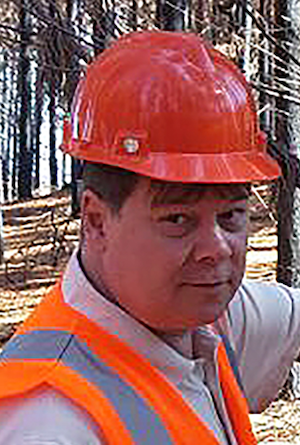 |
|
MARK FERGUSON |
This market has typically been served by high-flow skid steers/track loaders because the mulching heads require minimum hydraulic flow and pressure not available on standard-flow machines. But new mulching head offerings, like the Fecon standard-flow mulching head, can be operated by most standard-flow skid steers and compact track loaders. They need to provide between 17 and 27 gpm of hydraulic flow, have an enclosed cab that can be protected with polycarbonate guarding and can lift the 1,300-pound mulcher head.
The versatile mulcher head can be fitted with 22 knife- or carbide-type cutting tools. With a working width of 50 inches and stout construction, it is ideal for brush removal and land clearing jobs such as fencerow clean-up, lot clearing, invasive species eradication, trail work, wildland/urban interface clearing, cutting fire breaks and more. It allows rental centers with standard-flow models to serve customers such as landscapers, arborists, parks and recreational departments. The mulcher head is easily maintained and will provide years of service and rental income.
Another example is the stump removal market – skid steers and compact utility vehicles can be equipped with low-speed, high-torque auger-style stump grinders. Models like the Fecon Stumpex are inherently safer than wheel-type stump grinders because they do not send chips and possibly cutter bits flying. These auger-style stumpers can be used along city streets, in parks and other public spaces.
Clean-up is much easier and faster with auger-style stump grinders as well. Rental centers can offer a complete solution to a landscaper wishing to perform a project to remove brush, trees and stumps with a single skid steer and a couple attachments. The Stumpex attachment will provide years of service and income.
Track loaders attract DIYers
Trends in skid and track loaders can vary depending on the type of user, the application and the environment.
|
AARON HAYNES ERIC BURKHAMMER |
Users span a wide range from the weekend warrior or DIYer to large contractors. The needs of these users can be quite different. DIYers are typically homeowners focused on getting things done around the yard, which can include tasks like ground preparation before gardening or landscaping, digging postholes for fences or removing debris from their yards. These types of users generally have lower rated operating capacity requirements and lower auxiliary hydraulic flow requirements.
However, this group has a propensity to lean toward track loaders because of their ability to navigate uneven terrain and handle various types of ground conditions. DIYers may also have dimensional requirements that could influence machine selection. For example, gaining access to a fenced yard with a four-foot opening would limit the number of machines one could utilize. Machine transport is yet another consideration the DIYer user group needs to make when deciding what machine is right for them. Some DIYers may have a truck and trailer combination that would allow them to transport machines below a certain weight, while other DIYers may need to have equipment delivered to them.
Owner/operators are a substantial user group that tends to purchase their equipment, which is the result of them needing equipment more often and are less flexible with availability issues. Owner/operators need machines on a daily basis and likely do not have the time to visit several rental centers to locate the correct product for their job.
A group that still uses rental channels for machine acquisition with a similar usage frequency are large and small contractors. Contractors have a wide array of rated operating capacity requirements that is driven by the application. A key difference between DIYers and contractors, in general, is the length of the rental itself. The reason DIYers are commonly referred to as “weekend warriors” is because they may only need the unit for a weekend or two. Conversely, contractors may be working on jobs that last months.
Contractors work in a plethora of applications, which will influence the required rated operating capacity as well as the auxiliary hydraulic flow. For example, road construction may require high-flow auxiliary couplers to run attachments, but a machine working in demolition may only use a bucket and require a higher capacity.
If you combine the skid steer and track loader markets in 2019, compact track loaders account for seven out of every 10 units sold in North America. Rental customers are asking for track loaders because they are more maneuverable and can operate in softer soil conditions, making operators more efficient in their tasks. Additionally, the track loader has expanded operations into the fall and winter months as the machine can continue working in wet and less desirable conditions vs. machines with wheels.
When renting a machine, the main priority is getting the job done in a timely manner so the period the machine is needed does not exceed the length of the rental the customer has paid to use it. Extra time required to complete a job can create delays in projects along with additional costs. Track loaders seem to be the preferred machine by contractors and DIYers when it comes to the uses associated with compact dirt moving equipment.
Mini skid steers are increasing in capacity
The largest trend we are seeing with mini-skid loaders is customers purchasing larger capacity units. As mini-skid steers continue to increase in capacity and new product entrants emerge, the competition is fierce and growing.
 |
|
JASON SHOWERS |
It is estimated more than 40 percent of mini skid-steer sales are greater than the 900-pound rated operating capacity. Morbark, LLC, manufacturer of the Boxer mini-skid loader and Rayco articulated wheel loader, offers four models of track mini-skid steers and one model of articulated wheel loader. We are finding customers are gravitating toward larger capacity models to fill their rental product pipeline.
The Boxer line of mini-skid steers reaches an operating capacity threshold of 707 pounds. Morbark takes a different approach to the market for the greater than 900-pound rated operating capacity, by recently introducing the Rayco 1800AWL articulated wheel loader to satisfy customer requests for larger, more capable machines. The Rayco 1800AWL features an 1,800-pound rated operating capacity unit with suspension seat, articulated steering, telescoping boom, built-in counterweights, joystick-operated boom functions and mini-universal attachment plate.
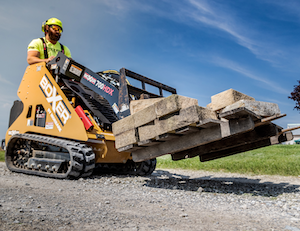 |
| The Boxer line of mini-skid steers reaches an operating capacity threshold of 707 pounds. |
We are seeing an increasing demand for the articulated wheel loader segment due to the larger operating capacity, seated operating position, higher lift heights and lower ground disturbance. While the mini-skid steer loader is still a viable alternative, offering its own advantages such as reduced size and weight, 360-degree viewing, easy on-off, spring-cushioned platforms and easy-to-use controls, many operators prefer to sit instead of stand.
Rental centers are not short of choices to fill their equipment needs. New products are emerging yearly, opening the path for the rental company to really dial-in on their needs and how best to serve their customer base. The Boxer mini skid-steer and Rayco articulating wheel loader feature a mini-universal attachment plate and identical quick coupling systems to allow rental customers to share attachments between equipment, decreasing upfront costs and increasing overall utilization between the two units.
This article was originally published in the May-June 2020 issue of Pro Contractor Rentals magazine. ©2020 Urbain Communications LLC. All rights reserved.



